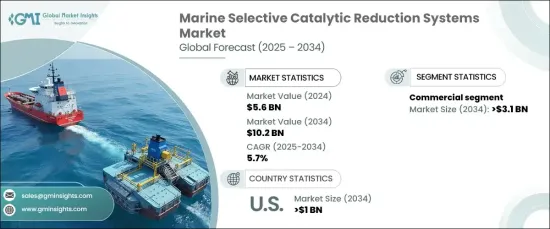
세계의 선박용 선택 촉매 환원 시스템 시장은 2024년 56억 달러로 평가되었고, 2025-2034년 연평균 복합 성장률(CAGR) 5.7%로 확대될 것으로 예측됩니다.
이러한 고급 배출 가스 제어 기술은 선박 엔진의 배기 가스에서 질소 산화물을 줄이기 위해 고안되었습니다. SCR 시스템은 촉매 컨버터와 요소 기반 시약을 사용하여 유해한 NOx를 무해한 질소와 수증기로 변환하는 화학 반응을 일으켜 작동합니다. 이 시스템은 해양기구의 Tier III 기준을 포함한 엄격한 환경 규제를 준수하고 해양 활동으로 인한 생태계에 미치는 영향을 최소화하기 위해 선박 운항 회사를 지원하는 중요한 역할을 담당합니다.

세계적 및 지역적 환경 기준 준수를 중시하고 선박용 SCR 시스템의 채택이 가속될 것으로 예상됩니다. 규제가 강화됨에 따라 이러한 시스템은 국제 해양법에 따라 배출량을 줄이는 효과적인 솔루션을 제공합니다. 또한 SCR 시스템은 해양 사업 환경 실적를 완화하는 기능을 가지고 있기 때문에 특히 오염과 기후 변화에 대한 세계 우려 증가를 고려하면 그 채택이 더욱 촉진됩니다.
| 시장 범위 | |
|---|---|
| 시작연도 | 2024년 |
| 예측연도 | 2025-2034년 |
| 시작금액 | 56억 달러 |
| 예측 금액 | 102억 달러 |
| CAGR | 5.7% |
선박용 SCR 시스템 시장의 상업용 분야는 2034년까지 31억 달러에 달할 것으로 예측됩니다. 국제무역 확대와 상업선박의 우위성은 SCR 시스템 수요 증가를 촉진할 것으로 예상됩니다. 해운회사는 지속가능한 관행의 채용에 중점을 두고 있으며, 이해관계자의 환경의식이 높아짐에 따라 규제기준을 충족시키는 압력이 높아지고 있습니다. 또한 주요 해운 거점이 국제 규제와 병행하여 지역 NOx 배출 규제를 시행하기 때문에 민간 선박 운항자는 규정 준수를 보장하기 위해 SCR 시스템을 설치해야합니다.
미국 선박용 선택 촉매 환원 시스템 시장은 2034년까지 10억 달러에 이를 것으로 예측됩니다. 배출가스 삭감을 목적으로 한 엄격한 규제와 노후화된 선대의 근대화를 추진하는 움직임이 결합되어 선진적인 배출가스 제어 기술에 대한 수요가 높아질 것으로 예상됩니다. 배기가스 규제가 엄격해짐에 따라 효율적인 SCR 시스템에 대한 요구는 특히 세계 조선 프로젝트 증가와 함께 강해질 것으로 보입니다. 이러한 요인의 총체로서 SCR 시스템이 배출가스 규제의 준수를 달성하고 해양산업의 환경 지속가능성을 향상시키는데 중요한 역할을 하는 것이 부각되고 있습니다.
The Global Marine Selective Catalytic Reduction Systems Market was valued at USD 5.6 billion in 2024 and is projected to expand at a CAGR of 5.7% from 2025 to 2034. These advanced emission control technologies are designed to reduce nitrogen oxides in marine engine exhaust gases. SCR systems work by using a catalytic converter and a urea-based reagent, triggering a chemical reaction that converts harmful NOx into harmless nitrogen and water vapor. These systems play a crucial role in helping marine operators comply with strict environmental regulations, including the International Maritime Organization's Tier III standards, minimizing the ecological impact of maritime activities.

The growing emphasis on adhering to both global and regional environmental standards is expected to accelerate the adoption of marine SCR systems. As regulations tighten, these systems offer an effective solution for reducing emissions in line with international maritime laws. In addition, the ability of SCR systems to mitigate the environmental footprint of marine operations further boosts their adoption, especially considering rising global concerns over pollution and climate change.
| Market Scope | |
|---|---|
| Start Year | 2024 |
| Forecast Year | 2025-2034 |
| Start Value | $5.6 Billion |
| Forecast Value | $10.2 Billion |
| CAGR | 5.7% |
The commercial application segment of the marine SCR systems market is anticipated to reach USD 3.1 billion by 2034. The growth of international trade and the dominance of commercial vessels are expected to drive increased demand for SCR systems. Shipping companies are becoming more focused on adopting sustainable practices, and as environmental awareness among stakeholders increases, the pressure to meet regulatory standards will grow. Additionally, as key shipping hubs enforce local NOx emission control standards alongside international regulations, commercial vessel operators will be compelled to install SCR systems to ensure compliance.
U.S. marine selective catalytic reduction systems market is projected to reach USD 1 billion by 2034. Stringent regulations aimed at reducing emissions, combined with the push to modernize aging fleets, are expected to drive the demand for advanced emission control technologies. As emission standards become more rigid, the need for efficient SCR systems will intensify, especially with the increasing number of shipbuilding projects worldwide. These factors collectively highlight the critical role of SCR systems in achieving emission compliance and improving the environmental sustainability of the marine industry.